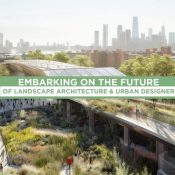Author: Carter Roy
Elevating Landscape Architecture: The Compelling Case for Integrating AI [Video]
In the ever-evolving landscape of technology, Artificial Intelligence (AI) has emerged as a transformative force across various industries. One domain where AI is making significant strides is within our own field of landscape architecture, promising to revolutionize the way we design, construct, and inhabit spaces. In this blog post, we’ll explore the compelling argument for embracing AI in landscape architecture and how it stands to reshape the future of our built environment.
Enhancing Design Creativity
Traditionally, landscape architecture has been a human-driven process, relying on the creativity and intuition of designers. However, AI is not here to replace designers but rather to augment their capabilities. AI algorithms can analyze vast datasets, identify patterns, and generate design alternatives, providing architects with fresh perspectives and creative insights. By collaborating with AI, landscape architects can push the boundaries of conventional design, fostering innovation and uniqueness in our endeavors.
Optimizing Efficiency in Planning and Design
The complexity of landscape architecture projects often involves intricate planning and design phases. AI can streamline these processes by analyzing historical data, predicting potential challenges, and proposing optimized solutions. This not only accelerates the design phase but also minimizes errors and enhances the overall efficiency of the designers’ workflow. As a result, designers can focus more on the conceptual aspects of their projects, confident that the technical details of a site are being handled with precision by AI systems.
Sustainable Design Solutions
In an era where sustainability is paramount, AI can play a pivotal role in achieving environmentally friendly design. By evaluating various parameters such as energy consumption, material efficiency, and environmental impact, AI can assist architects in developing sustainable design solutions. This not only aligns with global efforts to reduce our carbon footprint but also positions landscape architects as pioneers in the creation of eco-conscious built environments.
Data-Driven Decision Making
AI’s ability to process and analyze vast amounts of data empowers architects to make informed decisions. From site selection to material choices, AI can provide valuable insights based on historical data and real-time information. This data-driven approach minimizes uncertainties, reduces risks, and contributes to the overall success of architectural projects.
Conclusion
The integration of AI in landscape architecture represents a paradigm shift, offering designers unprecedented opportunities to push the boundaries of creativity, efficiency, and sustainability. As we embark on this journey towards a more technologically enriched future, embracing AI in this field is not just an option but a necessity. By fostering collaboration between human creativity and artificial intelligence, we can unlock a new era of innovation, shaping a built environment that is not only aesthetically pleasing but also intelligent, sustainable, and responsive to the needs of its occupants.
To learn more about AI and see its potential, check out my recent video that covers a program called Midjourney, a program which assists designers with front end creativity and idea generation at the early stages of design.
7 AI Image Generating Software You Should Know About [Video]
Artificial intelligence has made significant strides in various fields, and landscape architecture and design are no exceptions. In this rapidly evolving landscape, AI image-generating software is offering a wealth of creative possibilities. These tools are valuable for early concept development, idea testing, and even final renderings. While some of the best options come at a price, there are free alternatives that offer customization and unique features. In this video, I delve into the world of AI image generation and explore some of the programs that have already made their mark and those poised to revolutionize the industry. I have also recapped the video here for Land8 subscribers.
- Midjourney – The Popular Choice
One of the most well-known AI image generation tools is Midjourney, a prompt-style rendering tool that transforms your words into images or image series. Landscape architects and designers often use it to brainstorm and flesh out early design concepts. With the potential for more advanced prompt engineering, it could even become a viable tool for producing final renderings for presentations. While it’s no longer free, Midjourney is relatively affordable and offers a supportive community for learning and sharing insights.
- DALL-E – A Familiar Alternative
DALL-E, much like Midjourney, follows the prompt-based image generation model. Users type in prompts, and the software generates a variety of images based on those prompts. DALL-E, however, introduces a unique feature that allows you to extend an existing image, opening up creative possibilities. While it’s no longer free and requires purchasing credits, DALL-E remains a popular choice for those in the landscape architecture and design field.
- Adobe’s Generative Fill – A Game-Changer
For Adobe users, the Generative Fill option in Photoshop offers a powerful tool for image enhancement. You can circle an area on an image and provide a prompt for what you want to add or change. This tool is especially useful for inserting objects like trees, people, or other elements seamlessly, eliminating the need to hunt for PNGs and make them fit. As part of the Adobe ecosystem, this tool is a valuable addition for landscape architects and designers who use Adobe software.
- Adobe Firefly – The All-in-One Solution
Adobe Firefly is another remarkable AI image generation tool within the Adobe network. Similar to other image generation software, it relies on prompts to create images. However, Firefly offers additional features like creating color palettes from words, recoloring vector images, and generating 3D renders from model images. This all-in-one approach makes Firefly a robust choice for designers already using Adobe software.
- Stable Diffusion – The Free Customizer
For those looking for a free alternative, Stable Diffusion stands out. It offers the standard prompt-based image generation, but with an added twist. Users can select from different styles, parameters, and sizes to customize their results. This ability to fine-tune the generated images makes Stable Diffusion an attractive option for those who want more control over the final outcome.
- Crayon – An Abstract Twist
Crayon, another free AI image generator, has a unique abstract approach to image generation. While it may not be as polished as some other tools for architectural purposes, Crayon offers opportunities for experimenting with abstract designs. It can be particularly useful for creating custom PNGs and supporting graphics that complement main design concepts.
- Fotor’s AI Image Generator – The All-Rounder
Fotor’s AI Image Generator is another free tool that offers preset styles and customization options. It can be a valuable resource for landscape architects and designers who want to experiment with different image styles and parameters. Notably, it allows users to enhance existing photos, making it a handy tool for improving renderings and graphics.
By getting familiar with AI image generation tools early, landscape architects and designers can stay at the forefront of this exciting transformation. As the AI landscape continues to evolve, professionals should embrace these tools and stay prepared for the game-changing integration of AI into traditional design software. AI is not here to replace designers but to enhance their creative capabilities and streamline their work processes. It’s an exciting time to be part of the landscape architecture and design industry as we embrace the potential of AI.
5 Things You Should Know Before Studying Landscape Architecture [Video]
I’m excited to share some invaluable insights that I wish I had been privy to before embarking on my journey into the profession of landscape architecture in the video above and summarized below. It’s one of those fields that often stays under the radar until you stumble upon it in college or through a friend or family member already immersed in it. So, if you’re considering diving into the world of landscape architecture, buckle up and get ready for some key considerations!
5. You Don’t Need to Be an Artist
When I was first considering landscape architecture, I feared my lack of artistic background would be a roadblock. However, let me set the record straight – you don’t need to be a Picasso to succeed in this field. Sure, having an artistic flair can be beneficial, but landscape architecture is more about dedication and practice. It’s like that old saying: practice makes perfect. The more you invest your time and effort, the better you’ll become. Remember, we all start somewhere, and continuous improvement is the name of the game.
4. New Habits Will Form
Becoming a landscape architect comes with its unique set of habits, both good and not-so-great. Focusing on the minutiae and striving for perfection becomes second nature, sometimes even spilling over into our personal lives. I’ve embraced better organization habits, which turned out to be a silver lining. However, there’s also the pursuit of unattainable perfection and the perpetual need to stay productive. It’s a love-hate relationship with these habits, but they’re all part and parcel of the design school experience.
3. Design School is a Community
One of the unexpected perks of design school is the tight-knit community that forms. Since all your classes and professors are directly tied to your major, you’ll naturally form close bonds with your classmates and mentors. These relationships provide invaluable support and camaraderie throughout the challenging journey. Your classmates and professors will become friends for life, offering encouragement and shared experiences as you navigate the trials and tribulations of design.
2. A Different College Experience
Design school isn’t your run-of-the-mill college experience. It’s a demanding and all-consuming journey that sets it apart from other majors. While your friends in other disciplines enjoy their free time, you’ll be engrossed in your design projects, often working through the weekends. The sheer intensity of design school sets you on a unique path that doesn’t align with the typical college experience, but the rewards are well worth it.
1. It’s Expensive
Let’s address the elephant in the room – the cost. Depending on where you study, landscape architecture can get expensive quickly. The need for specialized tools, software, and drawing materials can take a toll on your wallet. If your school doesn’t offer free access to essential programs or printing services, those expenses can pile up. It’s crucial to factor in these costs when considering the landscape architecture path.
So, there you have it – my five insights to help you navigate the world of landscape architecture. I hope this peek behind the curtain prepares you for the exciting and challenging journey ahead. If you found this post helpful, don’t forget to hit that like button and subscribe to my channel for more design-related content. Until next time, stay inspired and keep creating!
—
Thumbnail Image: Dr. Michael A. Dirr leads a plant workshop at LABash Conference at University of Georgia, 2019. Photo by Sydonne Blake.
Should Landscape Architects Really Make the Switch to Revit? [Video]
In today’s fast-paced world, we are inundated with multiple software options capable of navigating us through all design phases. Yet, why do we find ourselves endlessly debating the correct software when they can theoretically produce the same results? Determined to find an answer, I embarked on a journey to discover the best program for Landscape Architects. This led me to create the video above that shares my discoveries and let’s just say… it left me feeling just as conflicted as before. For those who prefer not to watch, here are the key highlights:
- You Can’t Compare AutoCAD and Revit
One of the most evident issues in these debates is the attempt to compare AutoCAD and Revit. This is like comparing apples to oranges. AutoCAD serves Landscape Architects by creating 2-dimensional drawings, while Revit, a Building Information Model (BIM), offers a whole new dimension with live 3D modeling and advanced features. It’s unfair to pass judgment on either program without considering the individual project’s demands. For instance, residential projects might not require Revit’s collaboration and modeling capabilities, whereas large-scale projects would benefit significantly from these features. The key is to assess compatibility with your specific needs rather than focusing on which program is “better.”
- Becoming the Leaders We Aspire to Be
Another revelation came when shifting the focus from the power of the software to the teamwork aspect in our field. As Landscape Architects, we see ourselves as leaders in shaping the environment. To truly lead, we must embrace the latest technology. By adopting Revit and actively participating in a live working model with other disciplines, we can align ourselves in terms of scope and design updates. This ensures our ideas are considered at the same level as others, preventing the usual scenario where we provide updates after the fact when it’s too late.
- Growing Together, Not Separately
Lastly, imagine embarking on a journey across the world together, as opposed to separately. The answer is clear; it’s better to be united. While Revit might not be perfect for Landscape Architects now, it has the potential to be. Engaging more proactively with Revit and expressing our specific needs can lead to a tailored program. By evolving together through use, we avoid delays and ensure a better, more efficient tool for Landscape Architects.
In conclusion, the key lies in understanding the unique strengths of AutoCAD and Revit and aligning them with the demands of each project. By embracing technology, advocating for tailored solutions, and fostering collaboration, Landscape Architects can truly lead the way in shaping the future of software development in our field.










